How Intel’s Lunar Lake is Taking the Fight to its Competition
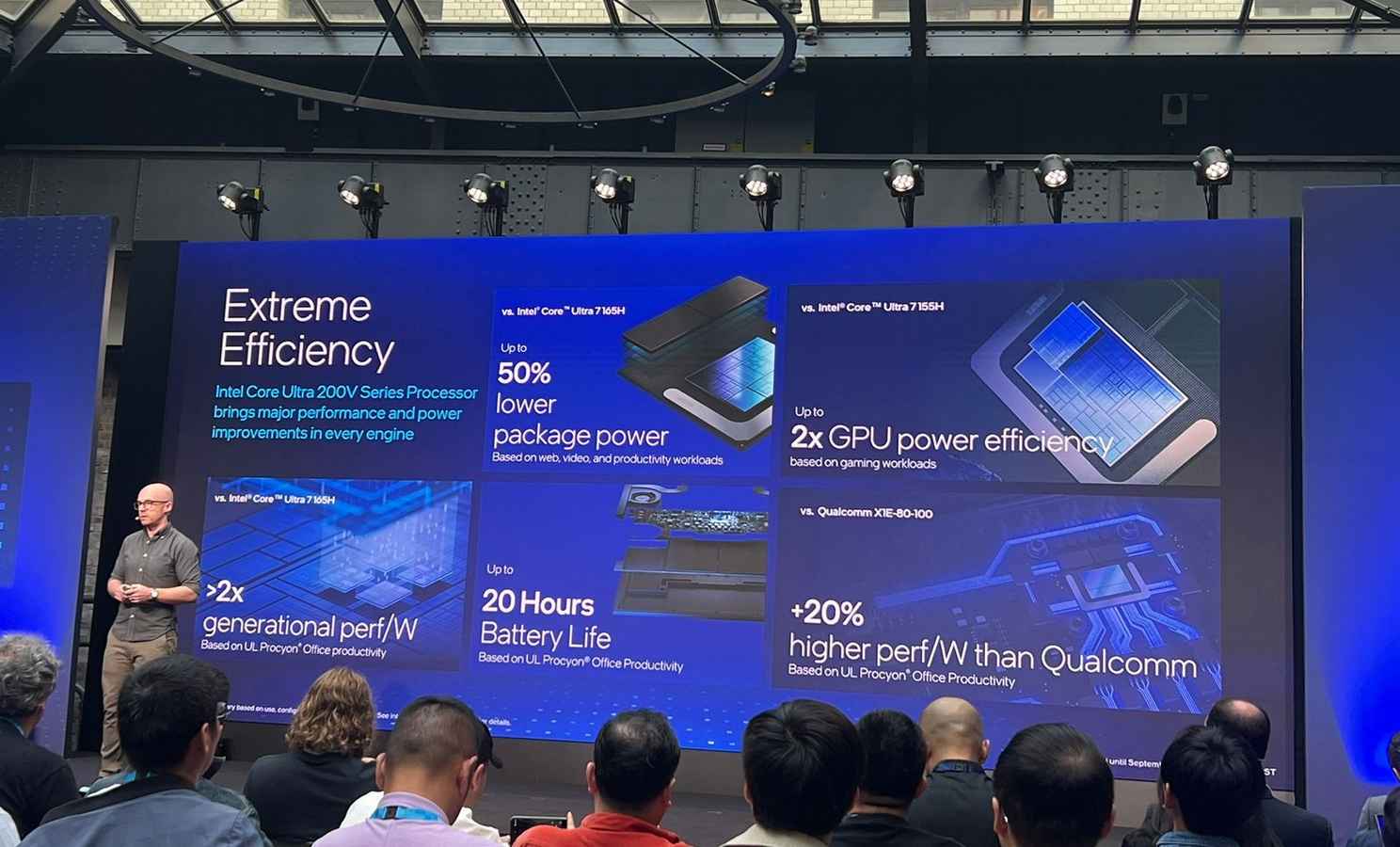
In a bold bid to reclaim its dominance, Intel has launched its most significant initiative to date: Lunar Lake. As Qualcomm and AMD gain ground, Intel is pulling out all the stops, making ambitious claims and putting its reputation on the line. At a press briefing in Berlin, Josh Newman, VP of Client Computing Group, set the stage for a paradigm shift in the AI PC landscape, stressing that a truly great AI PC demands a great overall PC. The Intel Lunar Lake series promises sweeping gains across the performance spectrum, boasting revamped CPU, GPU, and NPU engines optimized for efficiency and power. Key highlights include a significant leap in efficiency, directly challenging Qualcomm’s battery life claims, and a dramatically improved integrated GPU performance courtesy of Intel XE2, aimed at amplifying AI capabilities and gaming performance. Let’s get into the details of each performance engine and take a closer look at how Intel plans to regain its leadership position on the performance and efficiency front.
 Survey
SurveyAlso Read: Intel challenges Qualcomm and AMD with Lunar Lake launch
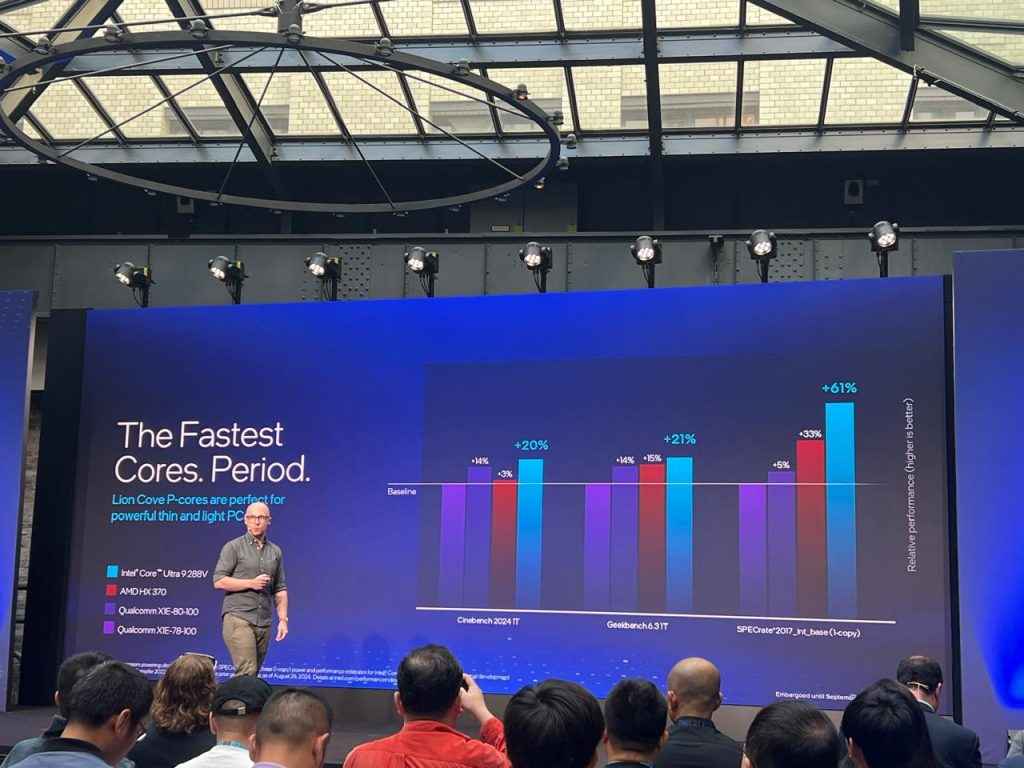
Most power-efficient Intel CPU ever
Intel’s Lunar Lake platform marks a significant milestone with the most power-efficient Intel CPU ever. The company has made bold and ambitious decisions, starting with 8-core configurations across the lineup, notably without hyperthreading. This deliberate choice aims to enhance performance per watt through a two-cluster approach, featuring four power-efficient E-cores for workloads that don’t require high performance. Building on Meteor Lake’s 2x Crestmont E-cores with a 2MB shared L2 cache, Lunar Lake boasts 4x Skymont E-cores with a 4MB shared L2 cache, introducing several enhancements. These include improved instruction prediction, increased parallelism with 26 dispatch ports, and deeper queueing for better resource utilization. Furthermore, the Skymont E-cores feature wider allocation and retire mechanisms, enabling E-core efficiency to match P-core performance levels. The Enhanced Memory subsystem, with 4x 128-bit FP & SIMD vector processing, claims to deliver double the AI throughput compared to the previous Meteor Lake platform. On the performance cluster, featuring four Lion Cove P-cores, Intel asserts the fastest single-core performance in the industry for thin and light AI PCs, within a power envelope of 8W-37W, with a maximum of 37W. Intel’s Lion Cove P-core architecture offers enhanced processing efficiency through improved scheduling capabilities and 18 execution ports, alongside access to up to 12MB of shared L3 cache for accelerated AI and compute-intensive tasks. Additionally, Intel highlights its AI-driven power management system and enhanced memory subsystem as key optimizations for power per area (PPA), with finer control over power consumption via 16.67MHz clock interval control. According to Intel, these advancements achieve a balance between performance and efficiency in its P-cores.
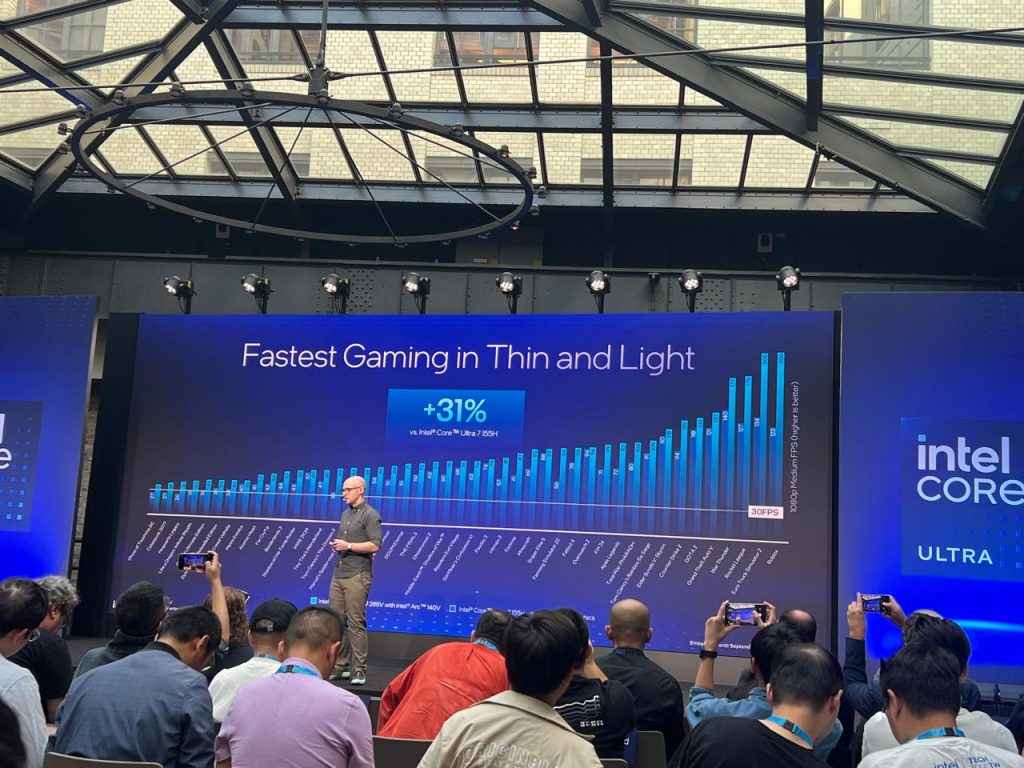
Fastest integrated graphics for thin and light PCs?
Does Intel’s Xe2 GPU Architecture Claim the Title of Fastest Integrated Graphics for Thin and Light PCs? Indeed, it does. The new Intel Xe2 GPU architecture boasts the fastest performance numbers for integrated GPUs in thin and light PCs. The Intel Arc 140V GPU features 8 cores with a maximum clock speed of 2.05 GHz, while the lower variant, the Arc 130V GPU, has 7 cores and reaches a maximum of 1.85 GHz. Intel claims an impressive 31% overall performance increase compared to the previous generation Xe1, which powered Meteor Lake-based laptops. During the performance briefing session, Intel showcased a gaming performance chart demonstrating thin and light laptops running on Intel Lunar Lake surpassing 60 FPS in numerous popular gaming titles at 1080p medium settings, with some games like Counter Strike 2, DOTA 2, and GTA V exceeding 120 FPS at 1080p medium settings. Intel didn’t hesitate to challenge Qualcomm’s gaming performance, claiming a significant 68% lead over Qualcomm Snapdragon X-Elite powered laptops at the same resolution and settings. Additionally, Intel took aim at its rival AMD, asserting an average lead of 16% over AMD when comparing the AMD Ryzen HX 370-based laptop to an Intel Core Ultra 9 288V-powered laptop. While Intel’s dominance over Qualcomm in gaming performance is unquestionable, the comparison with AMD Ryzen HX 370 is more nuanced, as both Intel and AMD will likely exchange blows depending on the games used for benchmarking. We eagerly await the opportunity to test the gaming capabilities of a Lunar Lake laptop.
Also read: Sneak Peek: Intel’s Robert Hallock on What to Expect from Lunar Lake
Staggering batterylife numbers
We checked out a few laptops at the demo zone and the common narrative across the show floor was “Highest battery life ever”. OEMs were eager to highlight the impressive battery life of their devices, and the claimed numbers were nothing short of staggering. For instance, the Lunar Lake-powered Dell XPS 13 boasted an astonishing up to 26 hours of battery life. Intel’s own rigorous benchmarking using the UL Procyon Office Productivity test claimed an impressive 20.1 hours of tested battery life for an Intel Core Ultra 7 268V-powered laptop, surpassing the 18.4 hours achieved by a Qualcomm Snapdragon X-Elite powered machine. Notably, Intel ensured a level playing field by using identical chassis and battery pack capacities for both devices.
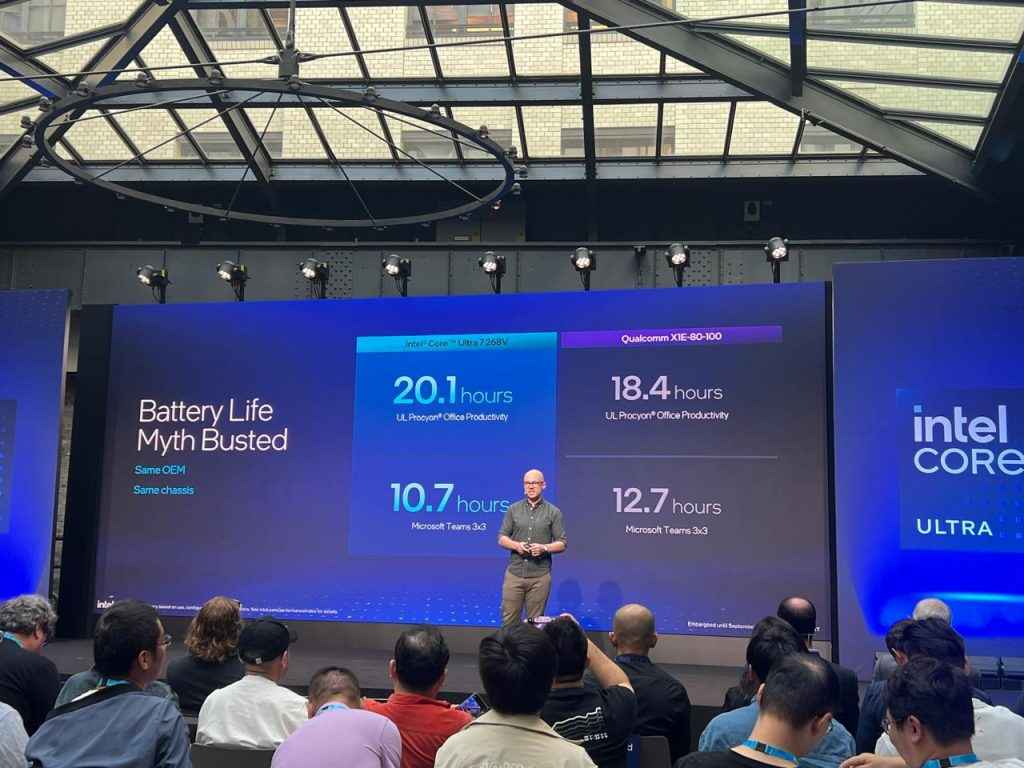
While battery life claims are not uncommon, it’s essential to consider the specific configurations, testing conditions, and workloads being used. However, Intel’s demonstration of superior battery life across various aspects, including graphics, processor, and battery life, suggests a strong readiness to challenge Qualcomm and AMD in this critical area. Intel’s consistent comparisons between Lunar Lake and Snapdragon Elite systems underscore its confidence in the platform’s capabilities. With Lunar Lake, Intel seems poised to shatter the myth that X86 PCs can’t deliver exceptional battery life.
AI performance
Before delving into the NPU improvement numbers, Intel emphasized the importance of a comprehensive AI PC framework. Intel asserts that while NPU performance is crucial, it’s not the sole determining factor for all AI workloads. Many AI tasks rely on the CPU and, more significantly, the GPU for execution. We concur with Intel’s stance on the vital role of a capable and power-efficient GPU, particularly in generative AI models where output time is more critical than power consumption. This explains Intel’s focus on its graphics engine in Lunar Lake. According to Intel, 40% of AI application developers prioritize GPU optimization for AI tasks.
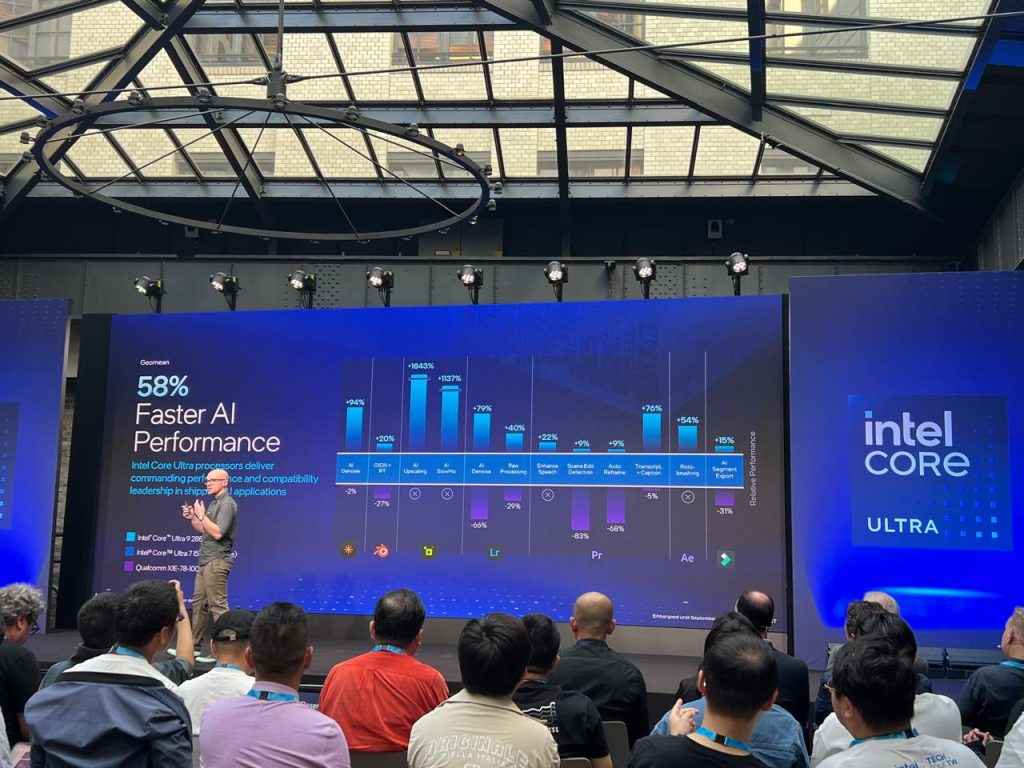
Lunar Lake-powered laptops can achieve up to 120 TOPS of combined AI performance, with the GPU reaching 67 TOPS, followed by the NPU at up to 48 TOPS, and the CPU at up to 5 TOPS. While TOPS is currently the standard measurement metric for AI performance, Intel notes that it may not be the most optimal or realistic measure. As AI performance and measurement benchmarks evolve, TOPS may become less relevant. Intel compared Lunar Lake performance numbers across UL Procyon AI benchmarks and Geekbench ML benchmarks to demonstrate its lead over Qualcomm and AMD. We look forward to testing our review unit to determine the true leader in AI benchmarks. By adopting a holistic approach to AI performance, Intel is poised to revolutionize the industry’s understanding of AI capabilities.
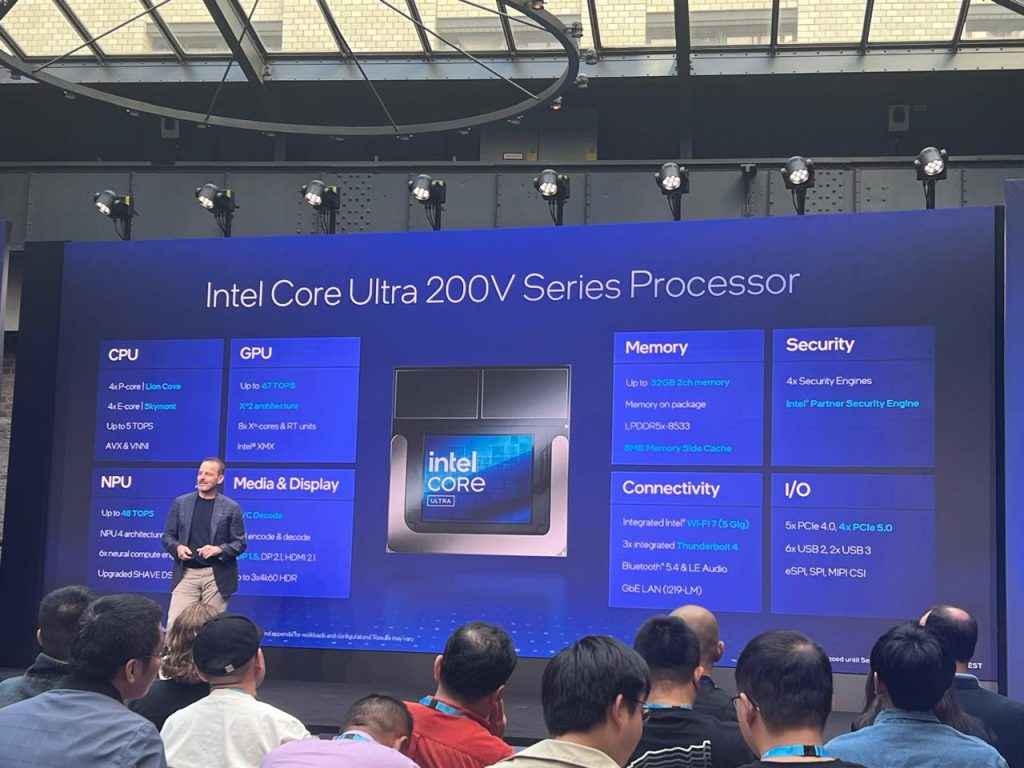
Shots fired!
The story is clear: Intel is pulling out all the stops to regain its crown in the space, particularly in terms of efficiency and AI performance. The goal is to shatter the myth that X86 PCs are incapable of delivering excellent battery life. If the numbers are to be believed, they may be well on their way to achieving this. However, this is not just a battle between Qualcomm or AMD and Intel; it’s a resurgence of the classic ARM vs X86 rivalry. We saw AMD emphasize performance during the launch of the AMD Ryzen AI 300 series in July, and now Intel is seeking to lead and define the narrative around power efficiency and performance per watt across CPU, GPU, and NPU. We will reserve our final judgment until we receive our review units based on the Intel Lunar Lake platform.
Soham Raninga
Soham Raninga is the Chief Editor for Digit.in. A proponent of performance > features. Soham's tryst with tech started way back in Dec 1997, when he almost destroyed his computer, trying to make the Quake II demo run at >30FPS View Full Profile